Duke Ellington “Piano In The Foreground” Columbia / Classic Records
- Performance:

- Sound:

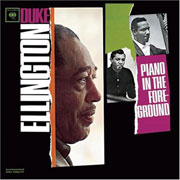
Duke Ellington was the man. I don’t know tons about him, and I haven’t even scratched the surface of his recorded output, but I find him to be one of the most intriguing personalities in the history of popular entertainment. Certainly a master of American entertainment and certainly a giant in the history of jazz. For those that are interested, I reviewed a Nat “King” Cole record for Secrets a couple of months back that was comprised of mostly instrumentals played on piano with sparse accompaniment from his bassist and drummer. I loved it. I wanted more, and found plenty on “Piano In The Foreground” by Ellington. The instrumentation is similar, and that’s where the comparisons end. Different mood, different plan, same incredible results. I actually think of Ellington’s record as the “jazzier” of the two while I consider Cole’s to be more of a “pleaser” for a general audience, not necessarily jazz fans. The Duke will throw you a curve ball on occasion while the King just lobs them over the plate. They both put the ball right where they want it, and my biggest challenge from here on out will be finding enough recordings of a similar caliber to satisfy my growing need. Sounds like we’re talking about something other than jazz which speaks to the depth of that art. I’m hooked. It’s that simple.
The Wikipedia entry for this record contains a quote describing it as a “somewhat forgotten session” which confounds me. Of course, the same site shows an Ellington discography that’s too massive to behold in one sitting so it makes sense that some of his work would be passed over. Clearly, he’s more famous as a band leader, and “Piano” displays his genius more as a player than as a conductor so it’s encouraging to know that there are aficionados out there to keep these lesser known works alive. There must be a market for it or the session would have fallen completely off the grid and we’d be none the wiser, right? That’s a scenario I don’t like imagining. Not when I hear “Cong-Go” oozing out of my speakers with the clarity and detail contained in these grooves. I can hardly recognize “Blues for Jerry” as blues, but it’s appropriately hostile in parts and tranquilizing in others so it would count for blues in my book no matter what structure Ellington chose. Gershwin’s “Summertime” starts side two, and I’ve yet to find a version that I personally consider more definitive. It’s a great lead-in to the more obtuse “It’s Bad To Be Forgotten.” If I were going to complain about anything in this set it would be that Classic Records chose to release the stereo version instead of the mono. That’s strictly a matter of preference on my part and I’m sure they utilized sound logic when making their selection (pun very much intended). Besides, I’m not going to complain. I think this is a remarkably beautiful piece by one of our greatest musical gifts. It makes me want to wear a monacle, read the classics, and write letters long hand with a fancy pen. I feel more sophisticated with it on the player. Maybe it’s just me…
I’m afraid, terrified really, that “Piano In The Foreground” is going to be one of the last Classic Records recordings that I get my hands on. It’s as stellar as any of their 200-gram titles in my collection, and you’ll know that I have a lot if you’re a regular reader of this column. I still haven’t found any info on the company’s apparent closure online so I’m reporting more or less on my personal assumption. I’ve contacted Michael Fremer via his website for confirmation and have not gotten a response yet. He’s considered the authority on vinyl these days as best I can tell so I expect him to know. (I have a documentary featuring Fremer at home from Netflix that I haven’t made time to watch. It’s called “It’s a Vinyl World After All” and it includes a tour of the pressing plant where Classic Records are/were born.) Regardless, I bought “Piano” on Ebay because my regular online retailers have begun gauging us on Classic Records pricing. For those interested, my vendor was actually Newbury Comics from New England, and I payed around $33 which is in line with other single-disc Classic albums. “Piano In The Foreground” makes a nice compliment to the other Ellingtons in my collection which include a much more challenging trio album featuring Ellington, Roach, and Mingus. I currently prefer both to my only listenable big band Ellington album. Of the three, I anticipate getting the most use out of “Piano In The Foreground.” I’d pick one up while the picking’s good, and probably a copy of it’s companion, the big band jazz “Piano In the Background,” while you’re at it.
Sonny Clark “Cool Struttin” Music Matters / Blue Note
- Performance:

- Sound:

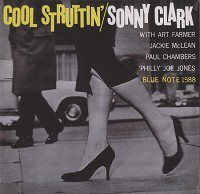
I’m developing a serious hard bop jazz habit, and the piano is working diligently to supplant the guitar as my favorite instrument. Sonny Clark was a hard bop jazz pianist so his classic “Cool Struttin'” seemed like an obvious choice for June. Normally, I would have purchased a copy on 200-gram Classic Records vinyl, but I’m weening myself off of their products since I won’t have access to them much longer. Luckily, Music Matters released “Cool Struttin'” on 45 r.p.m. double vinyl and I’ve been looking for an excuse to fork over some extra cash for their products too. “One man gathers what another man spills,” as the old lyric goes. I was blind going into this project as I’d never heard Clark play, and I’d never sampled Music Matters’s wares. I can see clearly now, and the future looks bright, folks. I’m stoked.
I was pretty positive that this record was going to be a mind-blower going in. I mean, I’m no genius. It’s not like I picked the Saints to win the Super Bowl in the pre-season or anything. It’s pretty simple when you look at the quality of work from the Blue Note label in general and specifically their titles that have been chosen for high quality vinyl reissue of late by whichever company you choose. I haven’t bought a bad one yet, and I’ve bought a few. This is one of the best so far. “Cool Struttin'” begins with a horn theme played by Art Farmer and Jackie McLean before Clark takes his first solo. It’s a mellow affair, and Clark gives literal meaning to the phrase “tickling the ivories” as his attack can hardly be described as an “attack” at all. He’s fluid and light and tasteful in the same way that modern day Russian spies are sneaky. That is to say that you almost don’t notice he’s there. He may have had seven fingers on his right hand. If he didn’t, he missed a good shot at it. Paul Chambers plays his bass solo with a bow on the title track too. All kinds of fun in these grooves. Lots of surprises. “Blue Minor” is more lively, and no less deep. “Philly” Joe Jones gets to work out a little on percussion before the solos here. By then, all the players have accounted for themselves. The level of talent from this era is legendary, and these guys show you why. The remaining two tunes are equally as impressive. This isn’t a record that you’re going to find used in the bargain bins as no one with the sense to buy it is going to take it back. Ever.
The sound quality on the Music Matters release is “over the top” great. The bass is low and tight and the highs are tight and shiny. My copy has a couple of pronounced “pops” within the first couple of measures which is a drag, but not enough of one for me to return the record. There wasn’t another copy available and I wouldn’t want to wait for a special order. There’s one thing that concerns me with this release in particular which is that it was originally released in mono in 1958. It wasn’t released in stereo until 1968, and my reissue is in stereo. Why, Lord? You get one song per side on this version which isn’t troubling to me as my apartment is four square feet. It may be something to consider if you’re averse to frequent movement as there’s a fair amount of record flipping going on. These discs are expensive, and I don’t know if my ear is developed enough yet to notice the sonic differences between the 33 r.p.m and 45 r.p.m. versions. I’m not plunking down the extra dough for comparison either. I mentioned in this month’s Duke Ellington review that I’d contacted Michael Fremer regarding the mysterious disappearance of Classic Records. He confirmed it without stating a reason for it. He did tell me that Classic sold their stock to acousticsounds.com, and a quick check of their site confirmed his claim. The prices are reasonable for most (not all) of them too. I’m glad to know it, and I’m happy to know that Music Matters is there to take up the slack. Their stuff is about $20 more per title. Choose wisely. And copiously. That’s my plan.
James Brown “Soul Classics Vol. 2” Polydor / Simply Vinyl
- Performance:

- Sound:

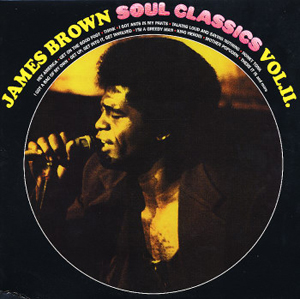
It’s hard to get a handle on the cultural impact that James Brown had in the sixties and seventies from this vantage point. Especially for me since I was not alive in the sixties, nor conscious for most of the seventies. But I can read, and therefore I know that he single-handedly quelled the riots after Martin Luther King Jr. was assassinated. Brown was scheduled to play the Boston Garden, and the conventional wisdom at the time suggested that the show should be canceled due to the civil unrest. Brown had a better idea. He suggested that the show not only go on but that it be televised nationally. The riots abated considerably throughout the duration of the broadcast, and the footage is blindingly hot. At that time, James Brown was a bad, bad man and he was at the peak of his super powers. He couldn’t draw more than 500 folks in his hometown of Augusta, Georgia by the time I saw him perform there in 1986. But that was our fault, not his. The show was as entertaining as any I’ve seen, and that held true for all of his performances that I attended until his passing a couple of years back. It’s easy to lose sight of his accomplishments and musical genius while focusing on his bizarre behavior and the tangled legal proceedings that he endured (and caused) later in his life. The “Soul Classics Vol. 2” compilation is a remedy for that type of amnesia. It’s comprised of songs from 1969 to 1973, and it’ll make your head spin faster than the man could spin himself. (That’s fast.)
A quick glance at the song titles shows that this was a political period for the icon. Songs like “Get Up, Get Into It, Get Involved,” and “Talking Loud And Saying Nothing” could groove your feet and move your mind with their funky wisdom while “King Heroin” is a slowed down novelty number with spoken word passages written from the drug’s perspective. It’s worth mentioning that the former songs both showcase Bobby Byrd’s vocals almost as much as his boss’s and that Byrd could easily have fronted the world’s baddest funk band if Brown hadn’t. Plenty of folks will be distracted by Brown’s manner of speaking during the latter, and the impact of the message is lessened by the common knowledge that Brown abused drugs if not heroine specifically. Still, it seems revolutionary for the time. The message in “Hey America” is a little confusing at first as I can’t figure out if Brown is criticizing the people flashing peace signs or the government that’s ignoring them, but all of that is made irrelevant by the song’s end when he’s back to imploring us to all get together which is always the point of Brown’s more political jams. And there’s plenty of party left in these grooves if politics isn’t your bag. The last song has my favorite title on any record anywhere. Who else would write a tune called “Let A Man Come In And Do The Popcorn,” and how much more fun can you have through music? Brown’s jams were so expansive that they came in parts one (“Get On The Good Foot”) and two (the aforementioned “Talking Loud”). “Think” is another classic represented in this set, and I could have sworn that it was recorded prior to 1969 which makes me wonder about the accuracy of the credits listed on the cover. That song at least feels older than the rest on “Soul Classics Vol. 2” which is a fine introduction to Brown’s work from this time for the uninitiated.
Here’s the really cool part. “Soul Classics Vol. 2” is a two-record set on 180-gram wax by Simply Vinyl from the U.K. This was the first boutique label that I discovered a few years back when I began collecting again. I’d lost track of them in the interim and I’m not even sure if they’re still releasing new titles. Their catalogue is still readily available, and a fine catalogue it is. I have one of their earlier releases by Bobby Byrd which I got signed at a James Brown show in Macon, Georgia. (I can’t say enough about Byrd. If his solo work isn’t on your radar, then you’re missing half of the funk picture.) And I also have Dylan’s “Blonde On Blonde,” and Tom Waits’s “Swordfishtrombones.” All of Simply Vinyl’s pressings are flawless in my experience and the depth of the sonic field is exceptional. My room fills with funk when the needle hits the groove on “Soul Classics Vol. 2” and I hope to find the first volume ASAP presuming it’s available. Until then, I’ll make due with what I have. And what I have was a “brand new bag” in its time. It was enough to bring peace to the streets in what was arguably this country’s most volatile period. Beat that.
Broken Bells “Broken Bells” Chysalis
- Performance:

- Sound:

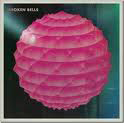
San Francisco is my favorite city for a lot of reasons. One, I live here so it might as well be my fave for as long as I’m around these parts. Secondly, I’m woefully behind on my world traveling goal so I just don’t know what I’m missing by not being elsewhere. Beyond all that, SF has a lot of great things going for it. A vibrant local music scene isn’t one of them. Folks would debate this with me given the opportunity, I’m sure. But I’ve lived in Athens, Georgia. I know what a happening local music scene looks like. Thankfully, I have friends that will never leave that glorious little burg, and I can keep up with what’s driving the kids crazy by checking in with the old folks back home. Currently, they’re listening to a band called Broken Bells and I don’t blame them one bit. The “band” consists of two folks and one of them is Danger Mouse. He was an Athens resident while I was there too, but I didn’t know it at the time. I’m not sure who did. I never heard a word about him, but the man’s gone on to do big things and now he’s one more notch in the Athens Band Belt, as it were. It’s a big belt, and his face is as deserving of being on the buckle as anyone’s.
Beats. That’s one thing that DM does well amongst a million other musical talents. But beats is mostly where it’s at for me. DM rose to prominence as the mastermind behind the masterpiece that is his “Grey Album” which melds the music of the Beatles “White Album” with raps from Jay-Z’s “Black Album.” Sounds hokey, and typically no one would be quicker to dismiss it as a novelty more quickly than I, but that disc absolutely kills. By that I mean it’s one of my favorite records of the last decade. It’s not an official release so you’ll have to find a pirated digital copy which I advise you do now. But I digress… James Mercer (of the Shins) handles the vocals and guitar on “Broken Bells.” Danger Mouse does everything else. And it’s the “everything else” that jumps off the grooves. Mercer doesn’t do anything embarrassing or otherworldly on these ten songs. He gives his cohort enough latitude to do what he does, and that mostly involves – your guessed it – intriguing beats. Mercer’s role is like Pau Gasol’s: do a serviceable job while you have the ball, then get the hell out of Kobe’s (DM’s) way. So far, none of the songs on “BB” have lodged themselves in my head. It’s more of a “let the music wash over you and seep into your life consciousness” kind of party. But a party nonetheless. These are fun little unobtrusive jams that’ll work quite well with the summer season. Lots of minor chords, and synth-drums, and echoes, and hand claps with mostly passive vocals. It might not change your life, but how often does a record like that come along anyway? When was the last one? I’m digging deep and getting a long ways from present day. Broken Bells played the Fabulous 40-Watt Club in Athens recently, and the report I got is that Mercer can’t hack it on stage. And that makes sense when listening to the record. It’s a studio creation, and lots of samples would be required to duplicate it in a live setting. There’s nothing wrong with that up to a point. But when do you just forget about a live performance when all sounds involved are pre-recorded anyway? The live litmus test isn’t necessary for every album release, and this might just be one of those. I don’t feel any great sense of loss as a result of the news, and it certainly doesn’t denigrate the quality of my home listening experience. I’m stoked that “Broken Bells” found its way into my collection as is, and there’s always a chance the guys just had an off night in Athens. Time will tell.
“Broken Bells” is a cool vinyl package. It’s a single heavy record, and the pressing is fine if not stellar. There were some markings on mine when I unwrapped it, but they don’t sound and the inner sleeve is of above average quality so hopefully that’s a trend that will stick. Speaking of trends, the digital download code is on a poster that is included with the vinyl version. The poster’s an old-fashioned bonus that seems to be regaining traction today. I can think of three new releases off the top of my head that came with them. And “Broken Bells” nods at the past by being more concise than most today as well. Five good songs on each side, and you’re done. It’s a perfect length for a perfectly listenable new record. Anything more would probably have seemed redundant. I’m not looking for a box set with B-sides and alternate takes here. Broken Bells got it right the first time and that’s mostly as a result of Danger Mouse’s expertise. Give the man the ball and get out of the way. That’s what I’d do.
Vic Chesnutt “At The Cut” Constellation
- Performance:

- Sound:

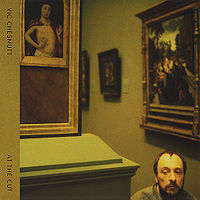
If someone were going to make a movie about Vic Chesnutt’s life, they could use his last album, “At The Cut,” as mood music throughout the production. Unfortunately, the story ends tragically when Chesnutt dies on Christmas Day 2009 as a result of an intentional overdose in Athens, Georgia. “At The Cut” suggests that scenario both literally and through the use of instrumentation, as the tension in the lyrics is as palpable as the chair I’m sitting in. The tone of a song like “Coward” would be ominous even without them. Chesnutt addresses suicide topically in “Flirted With You All My Life,” and I can only imagine how hard it must be for his friends and family to hear these songs now. Chesnutt’s catalogue is a diverse one, and I always gravitated to the darker material as is. For those who are more interested in the lighter side, there are records to recommend them. “At The Cut” is not one of them.
It’s difficult to know how much imagery I’m projecting onto these songs as a result of Vic’s passing, but it’s an easy trap to fall into even without the brutal news that will be forever linked to this collection of music. Chesnutt collaborated with many bands over the course of his career, most famously as a member of Brute with Widespread Panic, but this lineup really finds the shadowy underbelly of his most personal writing and brings that into such sharp relief that the listener flinches first if the listener feels anything at all. The band consists of players from Fugazi, Godspeed You! Black Emperor, and Thee Silver Mount Zion Memorial Orchestra. The players create some of the most cinematic sounds that I’ve heard in rock. Couple that with Chesnutt’s voice which is capable of symphonic expression on its own, and you’re left with one of the most emotionally complex popular works that I’m aware of in music. “Chinaberry Tree” is a standout vocal performance, and the impact is felt in the heart more so than the mind. I’ve heard it at least five times now, and I’m still unclear on the subject matter. The danger that starts side two as “Philip Guston” would be enough to send you scampering for safety making a song like “Concord Country Jubilee” almost seem like a vacation. But the effect can only be appreciated briefly as “Flirted With You All My Life” is still hiding in the wings. No Vic Chesnutt fan could get through this song with a smile knowing how soon the end came after this one was turned loose on his public. Words fail most all of us at some point, but they didn’t seem to fail Vic Chesnutt, and I doubt that they ever did. The man was functioning on a deeper level than I can fathom. There’s no way of knowing what makes up a person’s thought processes when the hour gets this desperate. I’m aiming for acceptance as understanding seems blessedly far off. I hope Chesnutt felt like he fulfilled his obligation to himself as an artist. It certainly sounds like he left it on the table when he presented us with “At The Cut.” It’s a masterpiece in my estimation. One that I’ll revisit for years to come.
It’s hard to comment on something like the quality of the vinyl that carries this content, but that’s why we’re here so it’s worth mentioning that this is one of the finer truly independent vinyl releases that I’ve seen in some time. The single heavy record is flawless save for one strange small marking that is visible on both sides. It doesn’t sound. All I hear is music, and lyrics, and pain, and transcendence. The set includes a CD of the work, two posters, and a lyric book too. “It Is What It Is” is my least favorite modern colloquialism, but one of my favorite songs on “At The Cut.” That’s kind of what makes Chesnutt’s work so magical. He’s taken one of our least favorite subjects and twisted it into one of the most engaging records in recent memory. The last time I saw him in person, he was navigating his wheelchair through a grocery store with a frozen pizza in his mouth. I guess he was making the most of the abilities that were available to him. And it sounds like he kept that up until his untimely end. We’re better off for it, and I’ll miss him as an artist. That’s about all I know to say.


